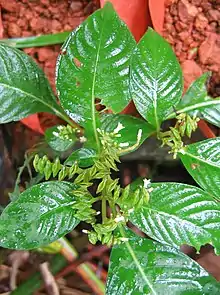| Ophiorrhiza | |
|---|---|
 | |
| Ophiorrhiza mungos | |
| Scientific classification | |
| Kingdom: | Plantae |
| Clade: | Tracheophytes |
| Clade: | Angiosperms |
| Clade: | Eudicots |
| Clade: | Asterids |
| Order: | Gentianales |
| Family: | Rubiaceae |
| Subfamily: | Rubioideae |
| Tribe: | Ophiorrhizeae |
| Genus: | Ophiorrhiza L. |
| Species[1] | |
|
372; see text | |
| Synonyms[1] | |
| |
Ophiorrhiza is a genus of flowering plants in the coffee family (Rubiaceae). It contains 372 species native to the Indian subcontinent, Indochina, China, Japan, Malesia, Papuasia, Queensland, and the South Pacific.[1] Species of the genus contain camptothecin, an alkaloid used to make chemotherapeutic agents.[2][3] Many Ophiorrhiza species are endemic to certain areas of the Western Ghats.
Species include:
- Ophiorrhiza acuminata[4]
- Ophiorrhiza blumeana[5]
- Ophiorrhiza bracteata[5]
- Ophiorrhiza cantoniensis
- Ophiorrhiza carinata
- Ophiorrhiza caudata[2]
- Ophiorrhiza dulongensis
- Ophiorrhiza filistipula
- Ophiorrhiza japonica
- Ophiorrhiza kuroiwai[6]
- Ophiorrhiza liukiuensis[4]
- Ophiorrhiza longiflora
- Ophiorrhiza lurida
- Ophiorrhiza major[5]
- Ophiorrhiza michelloides[7][8]
- Ophiorrhiza mungos
- Ophiorrhiza nutans
- Ophiorrhiza prostrata[9]
- Ophiorrhiza pumila[4][10]
- Ophiorrhiza rosea
- Ophiorrhiza rugosa
- Ophiorrhiza succirubra
- Ophiorrhiza meenachilarensis[11][12]
References
- 1 2 3 Ophiorrhiza L. Plants of the World Online. Retrieved 31 October 2023.
- 1 2 Joseph, G. and J. P. Joseph. Rediscovery of Ophiorrhiza caudata (Rubiaceae) from the Western Ghats of Kerala. Rheedia 19 45.
- ↑ Viraporn, V., et al. (2010). Correlation of camptothecin-producing ability and phylogenetic relationship in the genus Ophiorrhiza. Planta Med. in pub.
- 1 2 3 Sirikantaramas, S., et al. (2008). Mutations in topoisomerase I as a self-resistance mechanism coevolved with the production of the anticancer alkaloid camptothecin in plants. PNAS 105:18 6782.
- 1 2 3 Arbain, D, et al. (1998). Unusual indole alkaloids from Ophiorrhiza blumeana Korth. J. Chem. Soc., Perkin Trans 1.
- ↑ Asano, T., et al. (2004). Camptothecin production by in vitro cultures of Ophiorrhiza liukiuensis and O. kuroiwai. Plant Biotechnology 21:4 275.
- ↑ Chu, F., et al. (2006). Taxonomic Status of Ophiorrhiza michelloides (Masam.) X. R. Lo (Rubiaceae) in Taiwan. Taiwania 51:2 143.
- ↑ Nakamura, K., et al. (2006). Phylogenetic systematics of the monotypic genus Hayataella (Rubiaceae) endemic to Taiwan. Journal of Plant Research 119:657–661.
- ↑ Beegum, A. S., et al. (2007). Organogenesis from leaf and internode explants of Ophiorrhiza prostrata, an anticancer drug (camptothecin) producing plant. Electronic Journal of Biotechnology 10:1.
- ↑ Nakamura, K., et al. (2006). Homostyly and autogamy in Ophiorrhiza pumila (Rubiaceae) in the Ryukyu Archipelago. Journal of Japanese Botany 81:113–120.
- ↑ "meenachilarensis". universityofflorence.medium.com. universityofflorence.medium.com. 30 November 2020. Retrieved 8 December 2020.
- ↑ "Journal of Plant Taxonomy and Geography". Webbia. oaj.fupress.net. 75 (2): 231–236. 18 November 2020. doi:10.36253/jopt-8508. S2CID 230636509. Retrieved 8 December 2020.
External links
- Vascular Plants of Gaoligong Shan, Yunnan, China: Ophiorrhiza
- Darwin, S. P. (1976). The Pacific species of Ophiorrhiza (Rubiaceae). Lyonia 1:2.
This article is issued from Wikipedia. The text is licensed under Creative Commons - Attribution - Sharealike. Additional terms may apply for the media files.